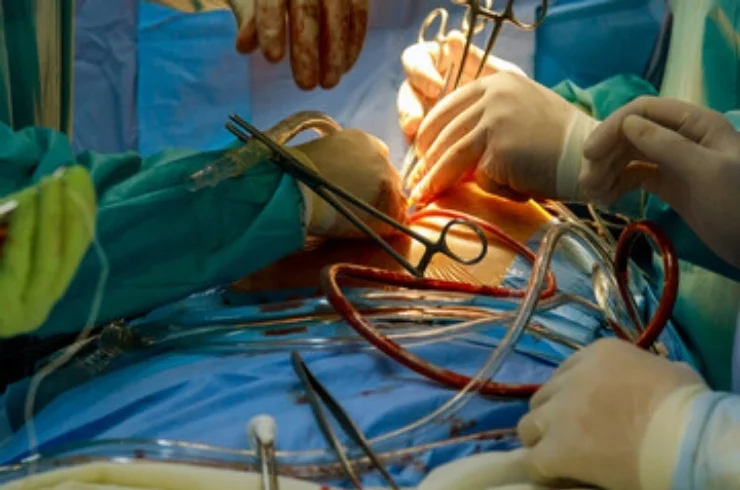Coronary Artery Bypass Grafting

Coronary Artery Bypass Grafting (CABG) is a surgical procedure designed to improve blood flow to the heart in patients with Coronary Artery Disease (CAD). CAD occurs when the coronary arteries, which supply blood to the heart muscle, become narrowed or blocked by a buildup of fatty deposits (plaque), reducing blood flow and oxygen supply to the heart. This can result in chest pain (angina), shortness of breath, and increase the risk of a heart attack.
At Kurnool Cardiac Center, under the expert care of Dr. Nagendra Prasad Thota, a highly experienced cardiologist and surgeon, we specialize in performing Coronary Artery Bypass Grafting (CABG) to restore normal blood flow to the heart and help our patients live longer, healthier lives.
What is Coronary Artery Bypass Grafting (CABG)?
CABG is a surgical procedure that involves bypassing blocked or narrowed coronary arteries to restore blood flow to the heart muscle. During the procedure, a healthy blood vessel from another part of the patient’s body (commonly from the chest, leg, or arm) is used as a graft. This graft is connected to the coronary artery before and after the blockage, creating a new route for oxygen-rich blood to reach the heart.
The procedure is typically performed when coronary artery blockages are severe or when non-invasive treatments, such as medication or angioplasty, are not effective.
Why is CABG Performed?
CABG is recommended in the following situations:
- Severe CAD: When coronary arteries are severely blocked or narrowed, and blood flow to the heart is significantly reduced.
- Uncontrolled Angina: When chest pain (angina) cannot be managed effectively with medication.
- Heart Attack Risk: To reduce the risk of a heart attack in patients with multiple blockages or critical narrowing of arteries.
- Improved Heart Function: CABG can restore heart function in patients whose heart muscle is weakened due to lack of blood flow.
How is CABG Performed?
The CABG procedure generally involves the following steps:
- Anesthesia: The patient is put under general anesthesia to ensure they are comfortable and pain-free throughout the surgery.
- Incision and Access: A large incision is made down the center of the chest to access the heart.
- Graft Harvesting: Healthy blood vessels, such as the internal mammary artery or saphenous vein, are removed from other parts of the body to be used as grafts.
- Bypass Creation: The surgeon attaches the grafts to the coronary arteries, bypassing the blocked areas and allowing blood to flow freely to the heart muscle.
- Closing the Incision: Once the grafts are in place, the incision is closed, and the patient is carefully monitored as they begin the recovery process.
In some cases, beating heart surgery is performed, where the heart is not stopped during surgery. However, in most cases, the heart is temporarily stopped, and a heart-lung machine is used to take over its function.
Benefits of CABG
CABG offers several life-changing benefits:
- Restores Blood Flow: The procedure restores proper blood flow to the heart, improving oxygen delivery to the heart muscle.
- Alleviates Angina: Most patients experience relief from chronic chest pain and discomfort.
- Reduces Heart Attack Risk: By bypassing blocked arteries, CABG reduces the risk of heart attacks in the future.
- Improves Heart Function: CABG helps improve the heart’s ability to pump blood efficiently and reduces the strain on the heart muscle.
- Enhances Quality of Life: Patients often experience a significant improvement in overall energy, physical stamina, and lifestyle after the surgery.
Potential Risks and Complications
As with any surgery, CABG carries some risks. These can include:
- Infection: Risk of infection at the surgical site or in the chest.
- Bleeding: There is a risk of bleeding during or after the procedure.
- Arrhythmias: Some patients may develop irregular heart rhythms (arrhythmias) after the surgery.
- Stroke: Though rare, a stroke can occur during or after surgery.
- Graft Failure: Over time, grafts may narrow or become blocked, requiring further medical intervention.
At Kurnool Cardiac Center, we take every precaution to minimize these risks and ensure the highest level of safety and care for our patients.
Post-Procedure Care
After CABG surgery, patients are closely monitored in the intensive care unit (ICU) for the first few days. Recovery generally includes:
- Pain Management: Pain and discomfort are managed with medications to ensure a smooth recovery.
- Monitoring: Heart function is closely monitored to ensure proper healing.
- Physical Therapy: Patients are encouraged to begin light physical activity to restore strength and mobility.
- Lifestyle Changes: To maintain heart health and prevent future problems, patients are advised to adopt a healthy lifestyle, which includes a balanced diet, regular exercise, and stress management.
- Follow-up Appointments: Regular follow-up visits are scheduled to monitor progress and ensure the grafts are functioning well.
Why Choose Kurnool Cardiac Center for CABG?
Choosing the right medical team for your Coronary Artery Bypass Grafting (CABG) procedure is crucial for the best possible outcomes. At Kurnool Cardiac Center, we offer:
- Expertise: Dr. Nagendra Prasad Thota, with his extensive experience in cardiology and heart surgery, leads our team in providing exceptional care.
- State-of-the-Art Technology: We use the latest technologies and advanced surgical techniques to perform CABG safely and effectively.
- Comprehensive Care: From consultation to surgery and post-operative care, we provide a complete package of care to help you recover fully.
- Patient-Centered Approach: We prioritize your comfort, well-being, and long-term heart health every step of the way.
Treatments
- ECG
- 2D Echo
- TMT (Treadmill Test)
- Angiogram
- Angioplasty
- Bypass Surgery
- Heart Failure
- Valvular Heart Diseas
- Arrhythmias
- Cardiomyopathy
- Congenital Heart Defects
- Lipid Disorders
- Coronary Artery Disease
- Coronary Angioplasty and Stenting
- Percutaneous Coronary Intervention
- Coronary Artery Bypass Grafting
- Mitral Valve Repair or Replacement
- Atrial Septal Defect Closure
Consult Kurnool’s Leading Heart Specialist
Reach out to Kurnool Cardiac Center and meet Dr. Nagendra Prasad Thota for advanced diagnostics and treatment.
